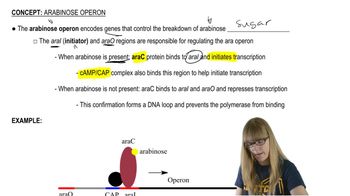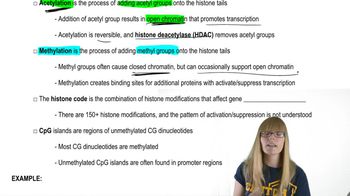Table of contents
- 1. Introduction to Genetics51m
- 2. Mendel's Laws of Inheritance3h 37m
- 3. Extensions to Mendelian Inheritance2h 41m
- 4. Genetic Mapping and Linkage2h 28m
- 5. Genetics of Bacteria and Viruses1h 21m
- 6. Chromosomal Variation1h 48m
- 7. DNA and Chromosome Structure56m
- 8. DNA Replication1h 10m
- 9. Mitosis and Meiosis1h 34m
- 10. Transcription1h 0m
- 11. Translation58m
- 12. Gene Regulation in Prokaryotes1h 19m
- 13. Gene Regulation in Eukaryotes44m
- 14. Genetic Control of Development44m
- 15. Genomes and Genomics1h 50m
- 16. Transposable Elements47m
- 17. Mutation, Repair, and Recombination1h 6m
- 18. Molecular Genetic Tools19m
- 19. Cancer Genetics29m
- 20. Quantitative Genetics1h 26m
- 21. Population Genetics50m
- 22. Evolutionary Genetics29m
13. Gene Regulation in Eukaryotes
Epigenetics, Chromatin Modifications, and Regulation
Problem 7a
Textbook Question
What are the roles of the Polycomb and Trithorax complexes in eukaryotic gene regulation?
 Verified step by step guidance
Verified step by step guidance1
Understand that Polycomb and Trithorax complexes are groups of proteins that play crucial roles in the regulation of gene expression in eukaryotic cells.
Recognize that the Polycomb complex is primarily involved in gene repression. It modifies chromatin to maintain genes in a silenced state, often through histone modifications such as methylation.
Identify that the Trithorax complex, in contrast, is associated with gene activation. It works to maintain genes in an active state, often by modifying chromatin to make it more accessible for transcription.
Explore how these complexes can act antagonistically to regulate developmental genes, ensuring that genes are turned on or off at the appropriate times during development.
Consider the dynamic balance between Polycomb and Trithorax complexes as a mechanism for maintaining cellular memory, allowing cells to remember their identity and function over time.
Recommended similar problem, with video answer:
 Verified Solution
Verified SolutionThis video solution was recommended by our tutors as helpful for the problem above
Video duration:
2mPlay a video:
Was this helpful?
Key Concepts
Here are the essential concepts you must grasp in order to answer the question correctly.
Polycomb Complexes
Polycomb complexes are multi-protein assemblies that play a crucial role in gene silencing and maintaining the repression of genes during development. They modify chromatin structure through histone modifications, such as trimethylation of histone H3 at lysine 27 (H3K27me3), leading to a compact chromatin state that is less accessible for transcription. This regulation is essential for controlling cell identity and preventing the expression of inappropriate genes.
Recommended video:
Guided course

Arabinose Operon
Trithorax Complexes
Trithorax complexes are another group of protein complexes that counteract the repressive effects of Polycomb complexes by promoting gene activation. They are involved in maintaining active chromatin states through histone modifications, such as trimethylation of histone H3 at lysine 4 (H3K4me3). This balance between Polycomb and Trithorax activities is vital for proper gene expression during development and cellular differentiation.
Recommended video:
Guided course

Arabinose Operon
Epigenetic Regulation
Epigenetic regulation refers to heritable changes in gene expression that do not involve alterations to the underlying DNA sequence. This includes mechanisms such as DNA methylation and histone modification, which can influence chromatin structure and accessibility. The interplay between Polycomb and Trithorax complexes exemplifies epigenetic regulation, as they establish and maintain gene expression patterns critical for development and cellular function.
Recommended video:
Guided course

Regulation






